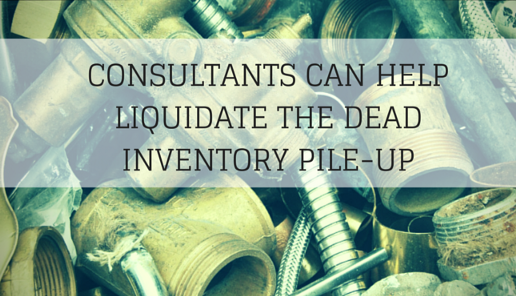Businesses in the normal course add useless inventory just as a normal person adds flab during the middle age. This is a natural phenomenon which can be considered as a feature of any business.
In the day to day busy schedule managing business, it is very difficult for owners/employees to set apart time specifically to liquidate the idle inventory. This task is not something that is to be done on a continuous basis. It may be required to be done once in a year or once in six months depending upon the nature, size and category of the business.
Idle inventory is not only a pain but it also acts as a magnet and keeps attracting more inventory into the stack. Businesses usually allot a room or a corner in their factory/premises storing things that are becoming useless and slowly people start dumping in more idle stuff there. Hence, Idle inventory starts to build in the business. If that corner or room was not there, the people would have discarded the obsolete goods properly without storing it in the room. The hope is that it may be useful at some future date.
A practical approach for every business looking to liquidate the idle inventory is to hire an outside consultant. The Consultant will help them segregate, categorize and realize the best value from the idle inventory of all sorts of spares, consumables, off spec. products that have been piled up. Doing this task using in-house employees involves complications and may result in a loss to the business.
A Consultant having specialized knowledge in many fields can add more value and better handle the diverse variety of materials. He will give undivided attention that this task deserves. Since he is a temporary hire, it will not result in a permanent regular expenditure for the business. This is an expense for which the ROI can be easily monitored. Into the bargain, liquidating the idle inventory will improve the bottom line of the business.
Listed below are some practical tips which consultants can use to identify the places where inventory pile up happens and blocks the capital:
1. Spares and Consumables of Machinery that has been Sold:
Every machine comes with sets of tools and spares for servicing and maintenance. Spares and consumables of sold machines is common in businesses that are upgrading to the newer models and automated machines.
Generally, the businesses forget to sell these spares and to dispose them off along with the machinery. When the machine has been sold, these additional spares and consumables cease to be of any use to the business and become idle inventory.
2. Raw materials of Discontinued Products:
Another example of idle inventory includes the stock of unused raw materials of discontinued products. Due to various reasons, the manufacturing of some products is discontinued by the businesses and their raw material becomes dead inventory.
Manufacturing businesses purchase the raw materials in specified packs and containers. When the manufacturing of a particular product is discontinued by the business, the raw materials of such products may not be fully used and part containers get added to the idle inventory.
3. New product launches that did not see Daylight:
Businesses launch new products or variants of existing products from time to time. Some products are successful and some not so successful. All these products require raw materials/components for their production.
Now when a final product fails, all the material related to its production, packaging etc. also becomes dead. Some components or materials may be common and can be used in the production of older products. Others which can not be so used find their way to the idle inventory room/corner.
4. Advertising Collaterals that are Obsolete:
A business spends on marketing and advertising in a number of ways. Business uses different types of advertising collaterals such as flyers, banners, posters, event bills and handouts, etc. to support the sales of a product.
The advertising collaterals are created specifically for a particular advertising campaign or an event. When the campaign or event has ended, these advertising collaterals become useless and are added to the pile of dead inventory. It is sensible to discard these advertising collaterals immediately after the ending of the campaign than storing them up as they are of no further use to the business.
5. Off Spec. Products:
In a manufacturing business, many off spec. products get manufactured that are not as per the required product specifications. These off spec. products can not be sold to the market as such. Generally, businesses store these off spec. products and add them to the idle inventory.
The consultant should advise the production people to blend/modify and alter these products suitably. Remaining products that cannot be rectified and find their way to the idle inventory room should be liquidated properly.
6. Dumps from Closed Branches, Offices and Godowns:
Dumps from old offices and godowns form a major part of the dead and useless inventory. Since the stakeholders are already relieved and transferred, this material has no caretakers and in most businesses they are left in no mans land.
Such items are of various types and cover more space with lesser realizable value. Dumps from old premises need to be reused in other offices where possible or a need is there. Rest can be treated as idle inventory and handled accordingly.
7. Rarely used Reagents, Test Equipments etc.:
It is common for every manufacturing business to have reagents and test equipments that have been used rarely. Keeping track of their shelf life is generally not done by the businesses.
For instance, in most pathology labs or labs of chemical industries, you can find expired reagents, outdated test equipments, etc. that get accumulated and are added to the stack of idle inventory.
The above are a few tips for locating the idle inventory in a business. Reduction in value of the idle inventory is a big loss and its timely liquidation can also help improve the profitability of the business. On a case to case basis, the consultant will find many such parameters and quick fixes for locating and identifying the dead inventory in different operations and divisions in large organizations as well the scrap corner of small scale organizations.
Both large organizations and small organisations need to hire consultants for this task due to a number of different reasons. In large organizations there are too many people with hierarchy structure and defined responsibilities. It is only easy to entrust the job to an outside consultant rather than trying to reorganize the whole structure and create chaos.
In smaller organisations, since there are too many roles being done by each person, they are always having pending and important chores to attend to. As a result, finding time for this inventory cleaning work gets neglected.
I am sure this can be a good ice breaker to initiate talk for a consultant with any organisation for a fresh consultancy assignment.



